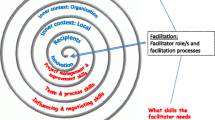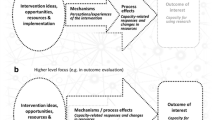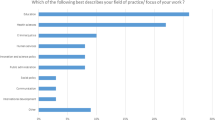Abstract
Current hypotheses for the existence of the ‘research-practice gap’ focus on weaknesses in research dissemination on the one hand and practitioner attitudes and motivations on the other. It is suggested that the gap has more fundamental origins in the cognitive and value mismatch between researchers and practitioners. To narrow the gap both cultures need to use a common framework (map and language) that is located at a level of analysis between their typical modes and makes explicit provision for the consideration of values. The decision analytic framework fulfils these requirements and it is therefore argued that all reports of research should include a decision analytic representation of the findings.
Similar content being viewed by others
References
Haines, A. and Jones, R. (1994). Implementing findings of research.British Medical Journal 308, 1488–1492.
Chalmers, T. (1974). The impact of controlled trials on the practice of medicine.Mount Sinai Journal of Medicine 41, 753–759.
Boissel, J.-P. (1989). Impact of randomized clinical trials on medical practices.Controlled Clinical Trials 10, 120S-134S.
Antman, E., Lau, J., Kupelnick, B., Mosteller, F. et al. (1992). A comparsion of results of metaanalyses of randomized controlled trials and recommendations of clinical experts: treatments for myocardial infarction.Journal of the American Medical Association 268, 240–248.
Furman, C. (1989). The impact of clinical trials on clinical practice.Arzneimittel Forschung / Drug Research 39, 986–988.
Kassirer, J. (1992). Clinical trials and meta-analysis: what do they do for us?New England Journal of Medicine 327, 273–274.
Lamas, G., Pfeffer, M., Hamm, P., Wertheimer, J.et al. (1992). Do the results of randomized clinical trials of cardiovascular drugs influence medical practice?New England Journal of Medicine 327, 241–247.
Fineberg, H. (1987). Clinical evaluation: how does it influence medical practice?Bulletin of Cancer 74, 333–346.
Grimshaw, J. and Russell, I. (1993). Effect of clinical guidelines on medical practice: a systematic review of rigorous evaluations.The Lancet 342, 1317–1322.
Grimshaw, J.M. and Russell, I.T. (1994). Achieving health gain through clinical guidelines I: Developing scientifically valid guidelines.Quality in Health Care 2, 243–248.
Grimshaw, J.M. and Russell, I.T. (1994). Achieving health gain through clinical guidelines II: Ensuring guidelines change medical practice.Quality in Health Care 3, 45–52.
Anon (1994). Implementing clinical practice guidelines.Effective Health Care 8.
Davis, D.A., Thomson, M.A., Oxman, A.D. and Haynes, B. (1992). Evidence for the effectiveness of CME: a review of 50 randomized controlled trials.Journal of the American Medical Association 266, 1111–1117.
Johnston, M.E., Langton, K.B., Haynes, B. and Mathieu, A. (1994). Effects of computer-based clinical decision support systems on clinician performance and patient outcome.Annals of Internal Medicine 120, 135–142.
Altman, D. (1994). The scandal of poor medical research.British Medical Journal 308, 283–284.
Culyer, A. (Chairman) (1994).Supporting Research and Development in the NHS, HMSO, London.
Peckham, M. (1994). A scientific basis for the National Health Service.Science in Parliament 51, 1013.
Anon (1992). Medical audit in general practice: effects on doctors' clinical behaviour and the health of patients with common childhood conditions [North of England Study of Standards and Performance in General Practice].British Medical Journal 304, 1480–1488.
Smith, R. (1994). Towards a knowledge based health service.British Medical Journal 309, 217–218.
Hamm, R. (1988). Clinical intuition and clinical analysis: expertise and the cognitive continuum. In,Professional Judgement: A Reader in Clinical Decision Making, ed. by J. Dowie and A. Elstein, Cambridge University Press, Cambridge.
Schön, D. (1983).The Reflective Practitioner: How Professionals Think in Action, Basic Books, New York.
Doubilet, P. and McNeil, B. (1985). Clinical decision making.Medical Care 23, 648–662.
Thornton, J.G. Lilford, R.J. and Johnson, N. (1992). Decision analysis in medicine.British Medical Journal 304, 1099–1103.
Sonnenberg, F., Roberts, M., Tsevat, J., Wong, J. et al. (1994). Towards a peer review process for medical decision analysis models.Medical Care 32, JS52–64.
Schwartz, W. (1979). Decision analysis: a look at the chief complaints.New England Journal of Medicine 300, 556–559.
McCrea, W. and Saltissi, S. (1993). Electrocardiogram interpretation in general practice: relevance to prehospital thrombolysis.British Heart Journal 70, 219–225.
Eddy, D. (1982). Probabilistic reasoning in clinical medicine: problems and opportunities. In,Judgement Under Uncertainty: Heuristics and Biases, ed. by D. Kahneman P. Slovic and A. Tversky, Cambridge University Press, Cambridge.
Lyman, G. and Balducci, L. (1993). Overestimation of test effects in clinical judgement.Journal of Cancer Education 8, 297–307.
Dowie, J. (1995). The dangers of partial evaluation: comment on Alan Williams 'Economics, QALYs and medical ethics: a health economist's perspective'.Health Care Analysis 3(3), 232–234.
Author information
Authors and Affiliations
Rights and permissions
About this article
Cite this article
Dowie, J. The research-practice gap and the role of decision analysis in closing it. Health Care Anal 4, 5–18 (1996). https://doi.org/10.1007/BF02251141
Issue Date:
DOI: https://doi.org/10.1007/BF02251141




